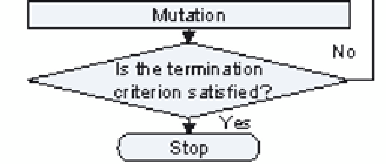Biomedical Engineering Reference
In-Depth Information
Artificial Neural Networks (ANNs)
Mizutani, 1997), this chapter will focus on the
MLP. Figure 2 provides an overview of the struc-
ture of this ANN. In this case, the ANN has three
layers of neurons—an input layer, a hidden layer
and an output layer. Each neuron has a number
of inputs (from outside the neural network or the
previous layer) and a number of outputs (lead-
ing to the subsequent layer or out of the neural
network). A neuron computes its output response
based on the weighted sum of all its inputs ac-
cording to an activation function. Data flows in
one direction through this kind of neural network
starting from external inputs into the first layer,
which are transmitted through the hidden layer,
and then passing to the output layer from which
the external outputs are obtained.
The ANN is trained by adjusting the weights
that connect the neurons using a procedure called
back-propagation (Bryson & Ho, 1975). In this
procedure, for a given input-output pair, the back-
propagation algorithm performs two phases of
data flow (see Figure 2). First, the input pattern
is propagated from the input layer to the output
layer and, as a result of this forward flow of data,
it produces an actual output. Then the error sig-
ANNs are a powerful set of tools for solving
problems in pattern recognition, data processing,
non-linear control and time series prediction.
They offer an effective approach for handling
large amounts of dynamic, non-linear and noisy
data, especially when the underlying physical
relationships are not fully understood (Cannas
et al., 2006).
At heart, ANNs are distributed, adaptive,
generally nonlinear learning machines comprised
of different processing elements called neurons
(Bishop, 1995). Each neuron is connected with
other neurons and/or with itself. The intercon-
nectivity defines the topology of the ANN. The
connections are scaled by adjustable parameters
called weights. Each neuron receives either exter-
nal inputs or inputs from other neurons to which
the neuron is connected and produces an output
that is a nonlinear static function of the weighted
sum of these inputs.
Although there are now a significant number
of neural network types and training algorithms
(Hagan et al., 1996; Haykin, 1994; Jang, Sun, &
Figure 1. A basic genetic algorithm


Search WWH ::

Custom Search